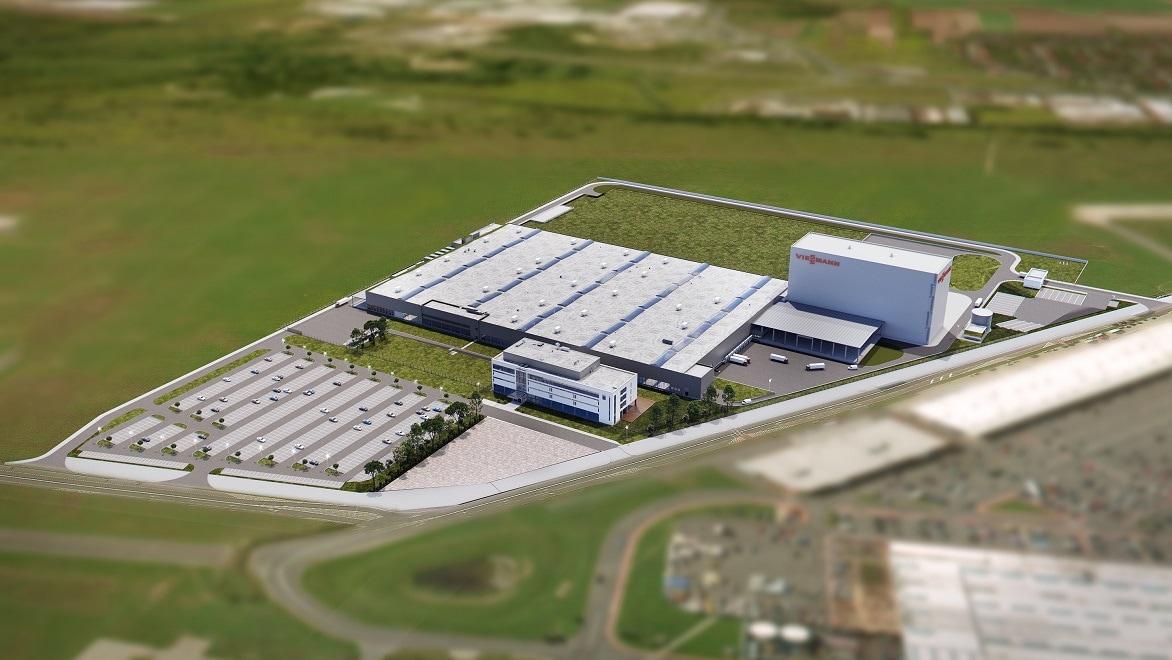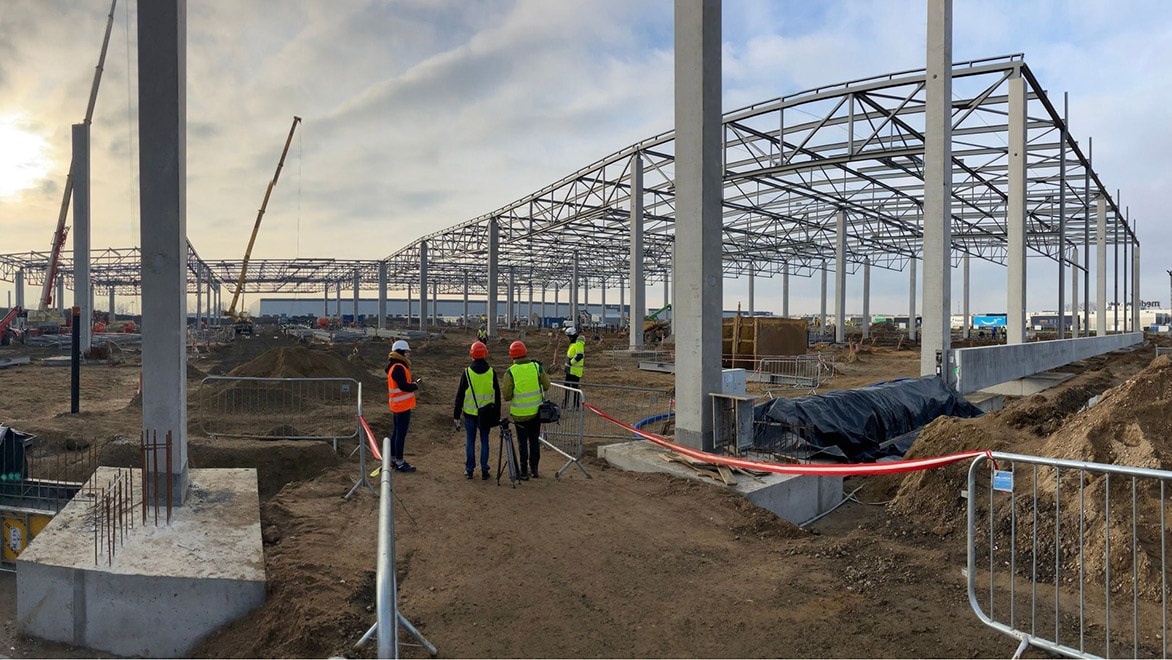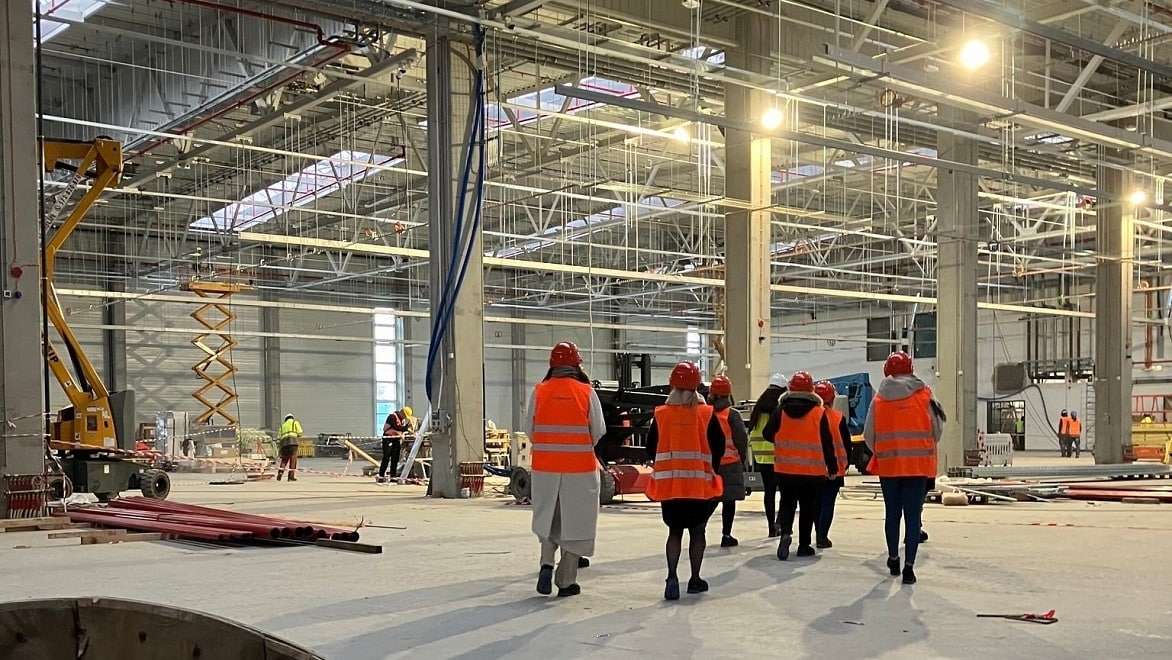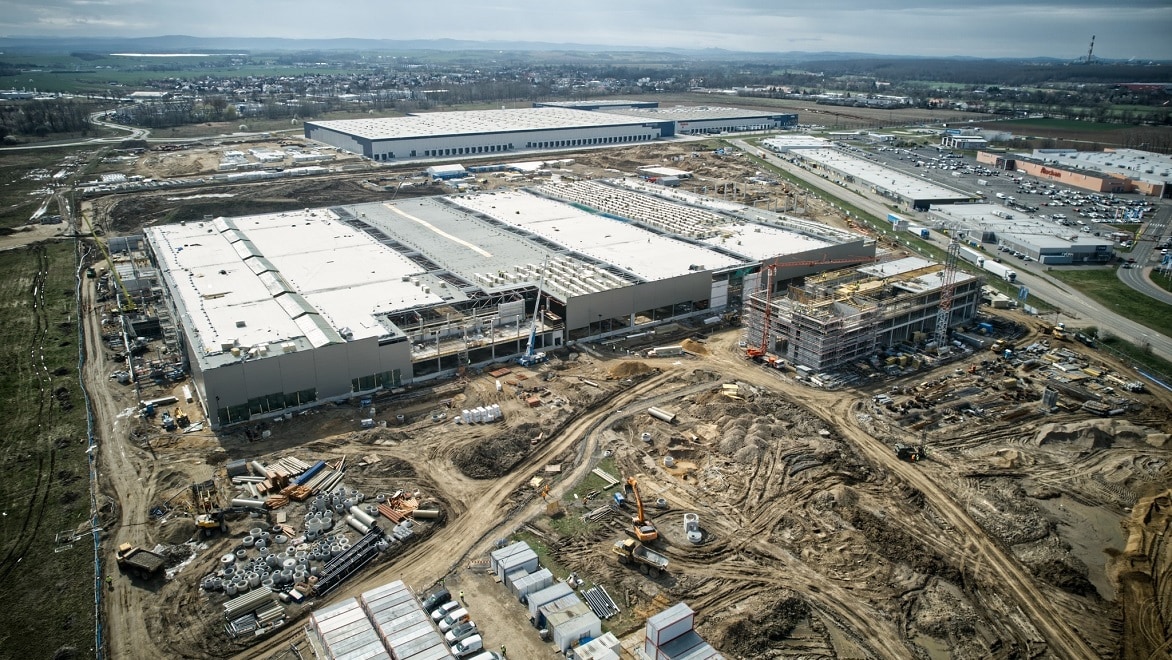VIESSMANN CLIMATE SOLUTIONS
Integrated factory modeling accelerates new plant construction
DESIGN & MANUFACTURING SOLUTIONS
Share this story
Digital technology improves collaboration and efficiency in development of a flagship heat pump factory
Viessmann, a global manufacturer of sustainable climate control systems based in Germany, is making a €1 billion investment in eco-friendly heating technology, starting with a new heat pump factory in Legnica, Poland. Viessmann is using integrated factory modeling tools and technologies to bring together diverse stakeholders—architecture, construction services, factory planning, production management—to build its new plant more rapidly, efficiently, and sustainably than ever before.

A rendering of Viessmann's heat pump factory in Legnica, Poland—a centerpiece of the company's expansion plans around sustainable energy solutions. Image courtesy of Viessmann Climate Solutions SE.
The clean energy revolution creates opportunity
As environmental and political pressures disrupt global markets and send energy prices into overdrive, consumers are demanding more efficient, environmentally friendly ways to heat their homes. Interest in alternatives to oil and gas heat has surged, and demand for heat pumps has skyrocketed. The global market for these electric-powered climate systems, which convert thermal energy from the air (or groundwater or geothermal sources) into home heating energy, is expected to grow by 8.1% annually.
For Viessmann Climate Solutions, a leading global provider of sustainable climate control solutions, this energy transition is a great opportunity. The Allendorf, Germany-based company recently partnered its climate solutions division with Florida-based Carrier Global Corporation to create a new global advocate for sustainable energy solutions.
Viessmann plans to invest a billion euros over three years to expand production of heat pumps and green air-conditioning systems. At the center of this initiative will be a new €200 million, 50,000-square-meter heat pump factory in Legnica, Poland. “More than ever, our goal is to drive the energy and heating revolution forward,” says Norbert Schmidt, digital factory expert at Viessmann.

The Legnica factory will incorporate modular, expandable manufacturing and test units, automated assembly processes, and automated logistics. Image courtesy of Viessmann Climate Solutions SE.
A facility optimized for efficiency and productivity
The Legnica heat pump plant will be a flagship facility for Viessmann’s climate solutions business, the largest business unit in the company. Its location in southwestern Poland positions the company to supply growing heat pump markets in central and eastern Europe. Viessmann will use the latest production technologies to maximize efficiency and enhance productivity across manufacturing processes—including an optimized manufacturing layout; modular, expandable manufacturing and test units; a centralized packaging area; automated assembly processes; and automated logistics with autonomous guided vehicles (AGV).
Sustainability is also a critical consideration in designing the facility—in particular, carbon neutrality and sustainable energy use. Viessmann has committed to making its operations net zero by 2050, and to get there, the company plans to reduce emissions from its own operations by at least 48% (compared to 2019 levels) by 2030.
“We plan to start producing heat pumps in Legnica in the fall of 2023, just about one year after laying the first foundation stone,” Schmidt says. With a tight timeline and an ambitious vision, Schmidt and the Viessmann team turned to integrated factory modeling to develop the new facility.

By using integrated factory modeling, Viessmann will be able to complete construction of the Legnica factory within one year. Image courtesy of Viessmann Climate Solutions SE.
Bringing teams together with integrated factory modeling
Integrated factory modeling combines Building Information Modeling (BIM) and digital factory planning to generate a digital representation of production facilities and equipment. It creates a central, always-up-to-date model that enables collaborators across disciplines to plan, design, validate, build, and operate factories. Project stakeholders can collaborate on factory planning and construction in real time using a 3D data model accessible via a cloud-based platform powered by Autodesk BIM 360.
“I’ve worked with CAD technology for more than 35 years, for both factory design and layout planning,” Schmidt says. “Today, we’ve achieved a new advantage with the introduction of BIM: The digital model has brought togethermany people from different companies.” For the Legnica project, this includes teams across the Viessmann organization, a planning contractor, an engineering firm, and many other trades subcontractors.
“The introduction of digital factory planning to our company brought us the advantage of collaborative planning and simultaneous engineering. The speed with which we were able to build was a great success, but even greater than that was the fact that the most diverse groups—from architecture to building services to factory planning to production management—could work together intensively.”
—Norbert Schmidt, Digital Factory Expert, Viessmann Climate Solutions

The Legnica factory's roof begins to take shape. Image courtesy of Viessmann Climate Solutions SE.
The digital model is a “single source of truth”
Concept design for the heat pump factory started in September 2021, and the detail design phase began a year later. The project team developed 3D models of the building and architecture plans with Autodesk AutoCAD and Revit, which were imported into the common data environment enabled by BIM 360. Autodesk Navisworks is used for model review and coordination, clash detection, and project control. Factory planning is done with Inventor, enabling the team to develop and review workflows to ensure they fit within the Viessmann ecosystem.
The combined digital factory model becomes a “single source of truth” that ensures that all teams are working from the same accurate information at all times. This model also helps design the facility to meet Viessmann’s goals for CO2 emissions and energy use by using the building properties to calculate total consumption and emissions for the factory in advance.
Viessmann will take the project data all the way through planning, construction, and operations—with plans to convert the 3D factory model to a digital twin that will be used for computer-aided facility management (CAFM). When the digital twin is populated with real-time operations data, the factory team will be able to address maintenance issues promptly and take preventative measures to avoid breakdowns.

Visitors tour the interior of the Legnica factory site under construction. Image courtesy of Viessmann Climate Solutions SE.
Integrated factory modeling delivers improved collaboration and greater efficiency
“The benefits of working together on a virtual model are huge,” Schmidt says. “All project participants—the owner, management, project managers, sub-trade planners, and onsite construction workers—can access the project data at any time, from anywhere.” Project status is constantly tracked and monitored in the model and continuous checks for clash detection prevent planning errors in the design phase.
As construction proceeds on the Polish facility, Schmidt says that integrated factory modeling will help Viessmann create more accurate plans, models, and schedules across all project phases; reduce the amount of rework required on the construction site; and deliver significant time and cost savings.
“In each project phase, we’re able to plan the objects, including building construction, steel construction, building services, machines, and plants, in the designated construction space on the virtual 3D model. We can compare them with other model components and execute them without collision,” Schmidt says. “This results in far more detailed planning depth and quality. Errors or missed deadlines are avoided at an early stage and ensure an efficient construction project. Risks and material wastage are minimized.”

Integrated factory modeling allows diverse Viessmann teams to work together seamlessly from planning to production management; as a result, the Legnica plant is on track to open in fall 2023. Image courtesy of Viessmann Climate Solutions SE.
The future of factory construction
With the heat pump plant on track for completion in late 2023, the advantages of integrated factory modeling over the traditional factory planning and design approach are evident. “The speed with which we were able to build our model was a great success, and management was always able to stay informed about current status,” Schmidt says. “But even greater than that was the fact that the most diverse groups—from architecture to building services to factory planning to production management—could work together intensively.”
From Schmidt’s perspective, integrated factory modeling is a best practice that Viessmann will carry into future projects. “The introduction of this method to our company brought us the advantage of digital collaborative planning and simultaneous engineering,” he explains. “We’re currently establishing a way to ensure knowledge transfer from previous projects in all company divisions.”
Schmidt sees even more potential with broader adoption of technology for factory planning and facility management within the company. “In my opinion, the advantages of planning with a 3D digital model can’t be denied,” he says. “Our goal for the future must be the acceptance and deepening of digitization. There is great potential here.”